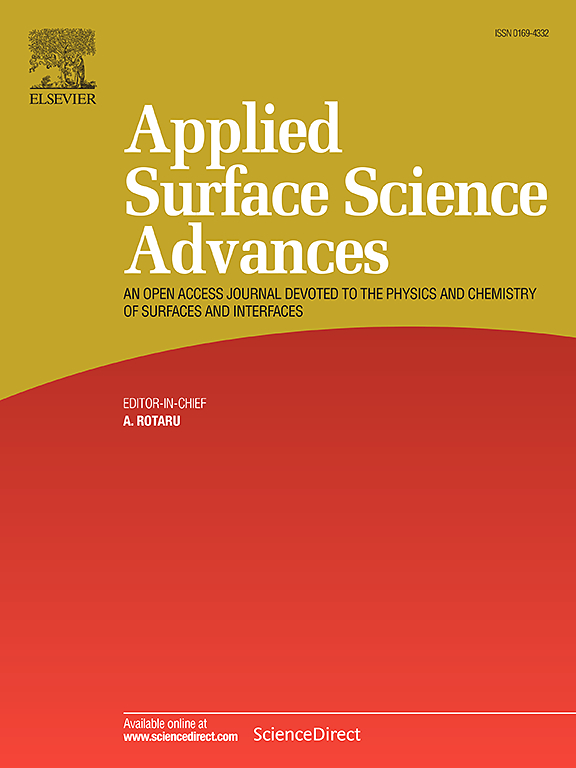Interfacial engineering-enabled nonlinear optical enhancement through OH vibrational coupling in MXene heterostructures
IF 8.7
Q1 CHEMISTRY, PHYSICAL
引用次数: 0
Abstract
This study investigates the nonlinear optical (NLO) properties of the Mo₂Ti₂C₃/2-amino-3-hydroxyphenazine (Mo₂Ti₂C₃/HAP) heterostructure, which was synthesized via an ultrasonication-centrifugation method. In the Mo₂Ti₂C₃/HAP heterostructure, the HAP binds to the surface hydroxyl groups of Mo₂Ti₂C₃, enhancing interfacial electron transfer efficiency. Inelastic neutron scattering (INS) analysis and density functional theory (DFT) calculations reveal a new vibrational mode at 850 cm⁻¹ at the heterostructure interface, which is attributed to O![]() H-coupled breathing vibrations, mediating the interaction between Mo₂Ti₂C₃ and HAP. Femtosecond transient-absorption spectroscopy analysis further indicates that this mode dominates electron-transfer dynamics from Mo₂Ti₂C₃ to HAP, leading to excited-state reabsorption within the Mo₂Ti₂C₃ lattice. This mechanism is directly evidenced by Z-scan measurements, revealing a distinct transition from saturable absorption (SA) to reverse saturable absorption (RSA), with a nonlinear absorption coefficient of βeff = 1.59 × 10⁻¹⁰ m W-1 at 520 nm excitation. These findings highlight the potential of the Mo₂Ti₂C₃/HAP heterostructure for advanced photonic applications.
H-coupled breathing vibrations, mediating the interaction between Mo₂Ti₂C₃ and HAP. Femtosecond transient-absorption spectroscopy analysis further indicates that this mode dominates electron-transfer dynamics from Mo₂Ti₂C₃ to HAP, leading to excited-state reabsorption within the Mo₂Ti₂C₃ lattice. This mechanism is directly evidenced by Z-scan measurements, revealing a distinct transition from saturable absorption (SA) to reverse saturable absorption (RSA), with a nonlinear absorption coefficient of βeff = 1.59 × 10⁻¹⁰ m W-1 at 520 nm excitation. These findings highlight the potential of the Mo₂Ti₂C₃/HAP heterostructure for advanced photonic applications.
MXene异质结构中OH振动耦合界面工程实现的非线性光学增强
研究了采用超声-离心法制备的Mo₂Ti₂C₃/2-氨基-3-羟基吩嗪(Mo₂Ti₂C₃/HAP)异质结构的非线性光学性质。在Mo₂Ti₂C₃/HAP异质结构中,HAP与Mo₂Ti₂C₃的表面羟基结合,提高了界面电子传递效率。非弹性中子散射(INS)分析和密度泛函数理论(DFT)计算揭示了850 cm处异质结构界面上的一种新的振动模式,这归因于oh耦合的呼吸振动,中介了Mo₂Ti₂C₃和HAP之间的相互作用。飞秒瞬态吸收光谱分析进一步表明,该模式主导了从Mo₂Ti₂C₃到HAP的电子转移动力学,导致Mo₂Ti₂C₃晶格内的激发态重吸收。z扫描测量直接证明了这一机制,揭示了从饱和吸收(SA)到反向饱和吸收(RSA)的明显转变,在520 nm激发下的非线性吸收系数为βeff = 1.59 × 10⁻¹m W-1。这些发现突出了Mo₂Ti₂C₃/HAP异质结构在先进光子应用中的潜力。
本文章由计算机程序翻译,如有差异,请以英文原文为准。
求助全文
约1分钟内获得全文
求助全文

 求助内容:
求助内容: 应助结果提醒方式:
应助结果提醒方式:


